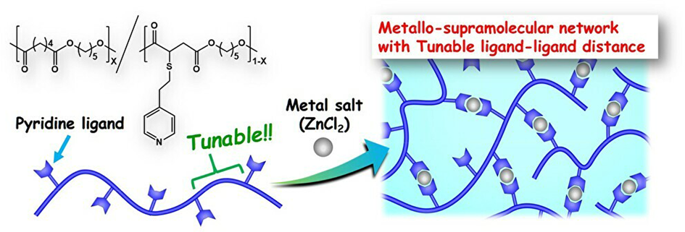Our official English website, www.x-mol.net, welcomes your feedback! (Note: you will need to create a separate account there.)
Glass transition analysis of model metallosupramolecular polyesters bearing pendant pyridine ligands with a controlled ligand–ligand distance
Polymer Journal ( IF 2.8 ) Pub Date : 2020-01-20 , DOI: 10.1038/s41428-020-0304-2 Mikihiro Hayashi , Haruna Obara , Keisuke Shibata , Kanta Sugimoto , Akinori Takasu
Polymer Journal ( IF 2.8 ) Pub Date : 2020-01-20 , DOI: 10.1038/s41428-020-0304-2 Mikihiro Hayashi , Haruna Obara , Keisuke Shibata , Kanta Sugimoto , Akinori Takasu

|
Supramolecular materials formed via metal-ligand coordination, so-called metallosupramolecular materials, have attracted attention due to their ability to modify a broad range of physical properties depending on the association strength at the coordination bond. Here, we demonstrate the correlation between the glass transition properties and the ligand distance by utilizing amorphous polyesters (denoted as PE-Py) with pendant pyridine ligands arranged homogeneously along the chain. The ligand distance is treated as the pyridine group equivalent molecular weight ( M Py ) and takes values of 900, 750, 550, and 420. The metal salt ZnCl 2 forms coordination bonds with the pyridine ligands, generating a metallosupramolecular network. The fraction of coordinated pyridine is finely tuned by the mole ratio between the pyridine ligand and ZnCl 2 ([Zn 2+ ]/[Py]) while adhering to the stoichiometric rule. DSC measurements reveal that the variation in the glass transition temperature ( T g ) with increasing [Zn 2+ ]/[Py] is closely correlated with 1/ M Py . Temperature-ramp rheological measurements are also performed, revealing that the apparent activation energy ( E a ) of segmental motion has a quasi-linear relationship with 1/ M Py . Thus, the present study demonstrates that the degree of restriction for segmental motion is very systematically strengthened as the ligand distance decreases, highlighting the importance of ligand distance in physical property control of metallosupramolecular materials. We here demonstrate the importance of ligand–ligand distance on physical property tuning of metallosupramolecular materials by utilizing model-like polyesters bearing pyridine ligands at the side groups with a controlled ligand-distance. The ligand distance is treated as the pyridine group equivalent molecular weight ( M Py ) and takes values of 900, 750, 550, and 420. The metal salt ZnCl 2 forms coordination bonds with the pyridine ligands, generating a metallosupramolecular network. DSC and rheological measurements revealed that the glass transition temperatures and apparent activation energy ( E a ) of segmental motion changes in a close correlation with 1/ M Py .
中文翻译:

带有受控配体-配体距离的吡啶侧基配体模型金属超分子聚酯的玻璃化转变分析
通过金属-配体配位形成的超分子材料,即所谓的金属超分子材料,因其能够根据配位键的缔合强度改变广泛的物理性质而受到关注。在这里,我们通过利用无定形聚酯(表示为 PE-Py)与沿链均匀排列的侧链吡啶配体来证明玻璃化转变特性与配体距离之间的相关性。配体距离被视为吡啶基当量分子量 (M Py ),取值为 900、750、550 和 420。金属盐 ZnCl 2 与吡啶配体形成配位键,生成金属超分子网络。配位吡啶的比例通过吡啶配体和 ZnCl 2 之间的摩尔比 ([Zn 2+ ]/[Py]) 进行微调,同时遵守化学计量规则。DSC 测量表明,随着 [Zn 2+ ]/[Py] 的增加,玻璃化转变温度 (T g ) 的变化与 1/ M Py 密切相关。还进行了温度梯度流变测量,揭示了节段运动的表观活化能 (E a ) 与 1/ M Py 具有准线性关系。因此,本研究表明,随着配体距离的减小,对分段运动的限制程度得到了非常系统的加强,突出了配体距离在金属超分子材料物理性质控制中的重要性。我们在这里证明了配体 - 配体距离对金属超分子材料物理性质调节的重要性,通过利用在侧基上带有吡啶配体的模型聚酯,配体距离受控。配体距离被视为吡啶基当量分子量 (M Py ),取值为 900、750、550 和 420。金属盐 ZnCl 2 与吡啶配体形成配位键,生成金属超分子网络。DSC和流变测量表明,玻璃化转变温度和节段运动的表观活化能(E a )变化与1/ M Py 密切相关。配体距离被视为吡啶基当量分子量 (M Py ),取值为 900、750、550 和 420。金属盐 ZnCl 2 与吡啶配体形成配位键,生成金属超分子网络。DSC 和流变学测量表明,节段运动的玻璃化转变温度和表观活化能 (E a) 的变化与 1/ M Py 密切相关。配体距离被视为吡啶基当量分子量 (M Py ),取值为 900、750、550 和 420。金属盐 ZnCl 2 与吡啶配体形成配位键,生成金属超分子网络。DSC和流变测量表明,玻璃化转变温度和节段运动的表观活化能(E a )变化与1/ M Py 密切相关。
更新日期:2020-01-20
中文翻译:

带有受控配体-配体距离的吡啶侧基配体模型金属超分子聚酯的玻璃化转变分析
通过金属-配体配位形成的超分子材料,即所谓的金属超分子材料,因其能够根据配位键的缔合强度改变广泛的物理性质而受到关注。在这里,我们通过利用无定形聚酯(表示为 PE-Py)与沿链均匀排列的侧链吡啶配体来证明玻璃化转变特性与配体距离之间的相关性。配体距离被视为吡啶基当量分子量 (M Py ),取值为 900、750、550 和 420。金属盐 ZnCl 2 与吡啶配体形成配位键,生成金属超分子网络。配位吡啶的比例通过吡啶配体和 ZnCl 2 之间的摩尔比 ([Zn 2+ ]/[Py]) 进行微调,同时遵守化学计量规则。DSC 测量表明,随着 [Zn 2+ ]/[Py] 的增加,玻璃化转变温度 (T g ) 的变化与 1/ M Py 密切相关。还进行了温度梯度流变测量,揭示了节段运动的表观活化能 (E a ) 与 1/ M Py 具有准线性关系。因此,本研究表明,随着配体距离的减小,对分段运动的限制程度得到了非常系统的加强,突出了配体距离在金属超分子材料物理性质控制中的重要性。我们在这里证明了配体 - 配体距离对金属超分子材料物理性质调节的重要性,通过利用在侧基上带有吡啶配体的模型聚酯,配体距离受控。配体距离被视为吡啶基当量分子量 (M Py ),取值为 900、750、550 和 420。金属盐 ZnCl 2 与吡啶配体形成配位键,生成金属超分子网络。DSC和流变测量表明,玻璃化转变温度和节段运动的表观活化能(E a )变化与1/ M Py 密切相关。配体距离被视为吡啶基当量分子量 (M Py ),取值为 900、750、550 和 420。金属盐 ZnCl 2 与吡啶配体形成配位键,生成金属超分子网络。DSC 和流变学测量表明,节段运动的玻璃化转变温度和表观活化能 (E a) 的变化与 1/ M Py 密切相关。配体距离被视为吡啶基当量分子量 (M Py ),取值为 900、750、550 和 420。金属盐 ZnCl 2 与吡啶配体形成配位键,生成金属超分子网络。DSC和流变测量表明,玻璃化转变温度和节段运动的表观活化能(E a )变化与1/ M Py 密切相关。


























 京公网安备 11010802027423号
京公网安备 11010802027423号